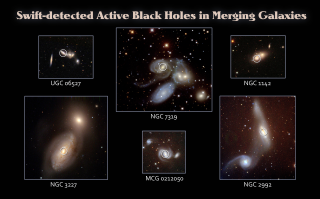NASA GSFC Swift 10-119 - 26 May 2010
Data from an ongoing survey by NASA's Swift satellite have helped astronomers solve a decades-long mystery about why a small percentage of black holes emit vast amounts of energy.
Only about one percent of supermassive black holes exhibit this behavior. The new findings confirm that black holes "light up" when galaxies collide, and the data may offer insight into the future behavior of the black hole in our own Milky Way galaxy. The study will appear in the June 20 issue of The Astrophysical Journal Letters.
The intense emission from galaxy centers, or nuclei, arises near a supermassive black hole containing between a million and a billion times the sun's mass. Giving off as much as 10 billion times the sun's energy, some of these active galactic nuclei (AGN) are the most luminous objects in the universe. They include quasars and blazars.
...
Until Swift's hard X-ray survey, astronomers never could be sure they had counted the majority of the AGN. Thick clouds of dust and gas surround the black hole in an active galaxy, which can block ultraviolet, optical and low-energy, or soft X-ray, light. Infrared radiation from warm dust near the black hole can pass through the material, but it can be confused with emissions from the galaxy's star-forming regions. Hard X-rays can help scientists directly detect the energetic black hole.
Swift Black Hole Survey Media Telecon VisualsThe optical counterparts of many active galactic nuclei (circled) detected by the Swift BAT Hard X-ray Survey clearly show galaxies in the process of merging. These images, taken with the 2.1-meter telescope at Kitt Peak National Observatory in Arizona, show galaxy shapes that are either physically intertwined or distorted by the gravity of nearby neighbors. These AGN were known prior to the Swift survey, but Swift has found dozens of new ones in more distant galaxies. Credit: NASA/Swift/NOAO/Michael Koss and Richard Mushotzky (Univ. of Maryland)
Goddard Multimedia Page

